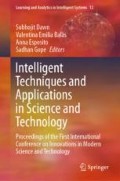Abstract
Physical and biochemical attributes are commonly used for characterization of rice. The physical attributes are related to the quantification of size, shape, colour and texture of the rice grains. Biochemical attributes are assessed from cooking and eating characteristics of rice and are termed like alkali spreading value (ASV), amylose content (AC), gel consistency (GC), grain elongation etc. Estimation of biochemical attributes are often time consuming and require meticulous effort for sample preparation, storage and manual measurement. The gelatinization temperature (GT) is related to Alkali spreading value of rice and is partly associated with the amylose content of the starch. GT has a negative correlation with cooking temperature of rice. In this paper image analysis technique has been proposed for discrimination of rice. A portable flat bed scanner has been used as the imaging device and image analysis software has been developed to measure the rate of dispersion during ASV testing. This machine vision technique is a faster and effective way to determine the ASV. The results obtained are promising towards this new approach for objective estimation of ASV.
Access this chapter
Tax calculation will be finalised at checkout
Purchases are for personal use only
References
Du, C.J., Sun, D.W.: Recent developments in the applications of image processing techniques for food quality evaluation. Trends Food Sci. Technol. 15, 230–249 (2004)
Little, R.R., Hilder, G.B., Dawson, E.H.: Differential effect of dilute alkali on 25 varieties of milled white rice. Cereal Chem. 35, 111–126 (1958)
Bhattacharya, K.R., Sowbhagya, C.M.: An improved alkali reaction test for rice quality. J. Food Technol. 7, 323–331 (1972)
Bhattacharya, K.R., Sowbhagya, C.M., Indudhara Swamy, Y.M.: Quality profiles of rice: a tentative scheme for classification. J. Food Sci. 47, 564–569 (1982)
Acknowledgments
The authors would like to thank Dr. (Mrs.) Monika Joshi, Scientist, IARI, PUSA for her valuable guidance and IARI, PUSA, New Delhi from where the sample were collected for this study. The authors are also grateful to the Department of Science and Technology, DST, Govt. of India for supporting the project.
Author information
Authors and Affiliations
Corresponding author
Editor information
Editors and Affiliations
Rights and permissions
Copyright information
© 2020 Springer Nature Switzerland AG
About this paper
Cite this paper
Akuli, A. et al. (2020). Discrimination of Rice Based on Alkali Spreading Value (ASV) by Machine Vision Technique. In: Dawn, S., Balas, V., Esposito, A., Gope, S. (eds) Intelligent Techniques and Applications in Science and Technology. ICIMSAT 2019. Learning and Analytics in Intelligent Systems, vol 12. Springer, Cham. https://doi.org/10.1007/978-3-030-42363-6_111
Download citation
DOI: https://doi.org/10.1007/978-3-030-42363-6_111
Published:
Publisher Name: Springer, Cham
Print ISBN: 978-3-030-42362-9
Online ISBN: 978-3-030-42363-6
eBook Packages: Intelligent Technologies and RoboticsIntelligent Technologies and Robotics (R0)

